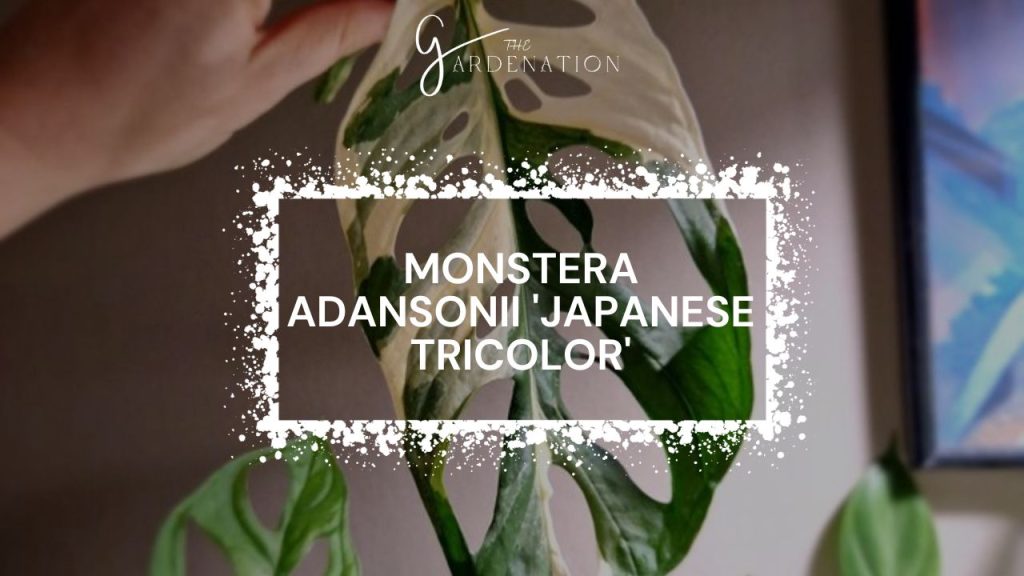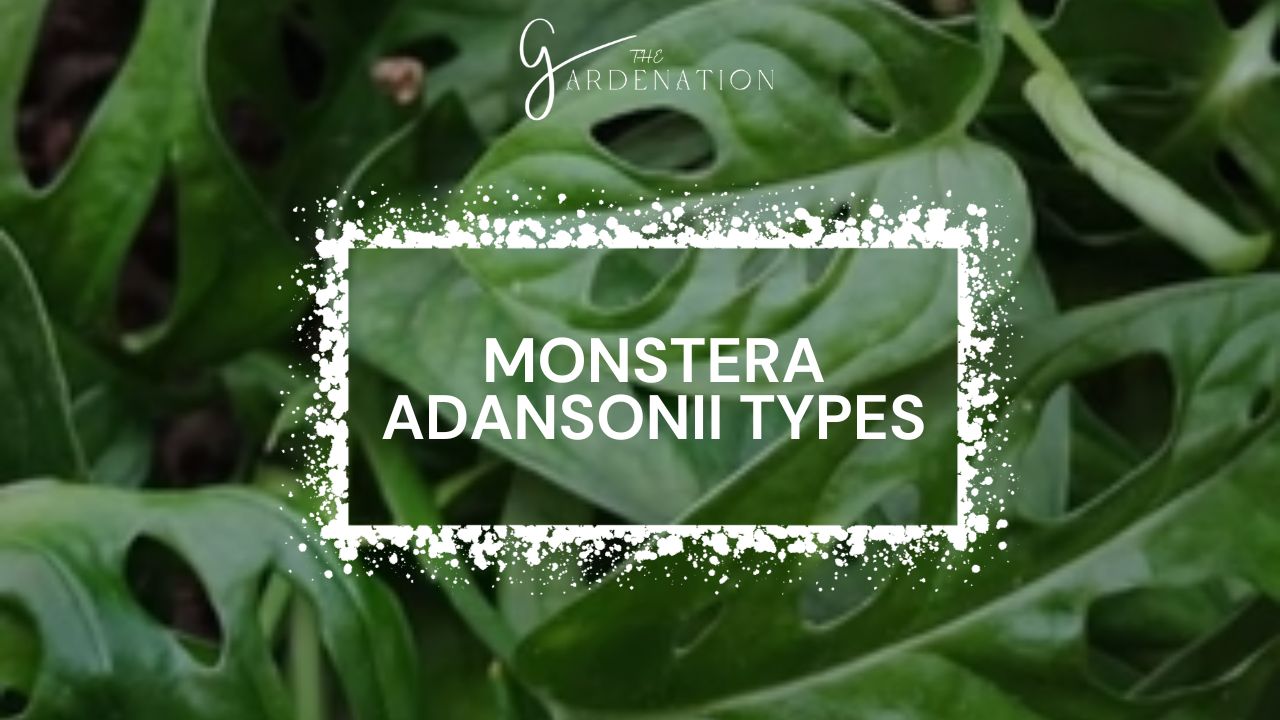Monstera Adansonii Types
The Monstera adansonii, also known as the Swiss Cheese Plant, has become an increasingly popular houseplant in recent years. Its distinctive heart-shaped leaves featuring iconic holes and fenestrations have graced everything from wallpaper to jewelry. This tropical aroid is relatively easy to care for and quick to propagate, leading to an explosion of interest, especially with the emergence of rare new cultivars. I have explored different Monstera Adansonii types.
As I explored the diverse forms of this captivating plant, I have discovered an intricate web of subspecies, varieties, and cultivars, each with its own unique characteristics. I will provide an in-depth look at the different types of Monstera adansonii, from understanding the key features that unite them as a species to appreciating the minute details that set each variety apart.
Understanding Monstera Adansonii

Monstera adansonii is a tropical, evergreen plant belonging to the Araceae family, which includes philodendrons, pothos, anthuriums and other aroids. Native to the tropical forests of Central America from southern Mexico to Panama, this species has adapted to thrive as an epiphyte, growing on trees and rocky outcrops where it can access better light exposure.
The Monstera genus gets its name from the Latin word for “monstrous” or “abnormal,” referring to the odd perforations that develop in the leaves as the plants mature in a process called fenestration. Monstera adansonii is named after the French botanist Michel Adanson. Among Monstera species, adansonii is one of the most popular for indoor cultivation, largely thanks to its iconic split and holey leaves, its versatility to grow in various conditions, and its easy propagation.
Within the species, there exist several subspecies, each with slight botanical differences. Understanding these intra-species classifications can help provide clarity on the diversity found within Monstera adansonii as a whole.
Subspecies of Monstera Adansonii

Monstera adansonii subsp. adansonii

Also referred to as the ‘Type’ subspecies, Monstera adansonii subsp. adansonii is considered the most common form in cultivation. It features the classic Monstera adansonii morphology – ovate, asymmetric, heart-shaped leaves that develop signature holes and notches as it matures. The leaves can grow over 30cm long on this fast-growing, climbing subspecies.
Monstera adansonii subsp. klotzschiana

Native to South America, the Klotzschiana subspecies has smaller, thicker leaves that start out lanceolate then become oval-shaped as the plant vines. The holes tend to be rounder compared to the iconic heart-shapes of subsp. adansonii. This plant may be labeled Monstera adansonii var. klotzschiana.
Monstera adansonii subsp. blanchetii

The Blanchetii subspecies bears a close resemblance to subsp. adansonii but produces even larger leaves and wider fenestrations in a more rapid growth rate. However, this rare form can be challenging to find in cultivation. It’s named after the French botanist Jacques Blanchet, who collected specimens in Brazil in 1833.
Monstera adansonii subsp. laniata

Also sometimes labeled as Monstera friedrichsthalii, this subspecies has smaller, oval leaves that remain under 15cm in length. The leaves are a darker green and the holes are narrower compared to the iconic heart-shapes of subsp. adansonii.
Understanding Lookalikes
While the genus Monstera contains around 60 species, several common houseplants are often confused with being a type of Monstera adansonii. To clarify:
- Monstera acuminata features elongated, pointed leaves.
- Monstera epipremnoides has smaller leaves with no slits or holes.
- Monstera punctulata has dotted stems and no fenestrations in the leaves.
- Monstera obliqua is rare in cultivation and has paper-thin leaves full of irregular holes.
All Monsteras belong to the Araceae family and share a hemiepiphytic climbing growth habit and similar botanical structures like petioles, nodes and bracts. However, understanding the distinctions helps properly identify and care for these delightful plants. Proper identification also ensures we don’t over-collect rare species like obliqua.
For more information about Kitchen Garden you can visit: Lettuce Growing Stages
8 Unique Varieties of Monstera Adansonii
- While the most common form has deep green leaves, there are also many named cultivars of Monstera adansonii to collect and enjoy:
Monstera Adansonii (Green Form)

The iconic green form with its heart-shaped leaves featuring signature fenestrations is the most readily available variety. It’s easy to grow and makes an excellent beginner’s houseplant.
Monstera Adansonii ‘Archipelago’

This variety has beautifully speckled leaves featuring variegated patches of white marbling. It grows slower than the green form and appreciates bright, indirect light to maintain its delicate patterning.
Monstera Adansonii ‘Aurea’

The bright yellow and lime green variegated leaves of Aurea infuse any space with cheer. I provide bright light to encourage vibrant variegation but I avoid direct sun which can burn the yellow patches.
Monstera Adansonii ‘Half Moon’

Half Moon features unique bi-colored foliage, split between green on one side and white on the other when mature. I grow this unstable variegant in bright indirect light to encourage the strongest variegation possible as leaves emerge.
Monstera Adansonii ‘Indonesia’

This variety has leaves with a unique blue-green mint tone. Originally from Indonesia, as its name suggests, it grows well in terrariums or paludariums that mimic its native tropical habitat.
Monstera Adansonii ‘Japanese Tricolor’

Each leaf of Japanese Tricolor features a striking mosaic of green, white and cream variegation. The variegation can be unstable in lower light. I provide excellent care to maintain its gorgeous coloring.
Monstera Adansonii ‘Laniata Variegated’

The laniata subspecies develops petite, oval leaves with a rippling edge. This rare variegated form has dark green leaves with artistic white splashes and speckles throughout each leaf. It’s slow growing and makes a lovely terrarium specimen.
With over 60 Monstera species and even more cultivars being introduced by hobbyist collectors and professional growers, there’s no shortage of diversity to appreciate among these tropical aroids. By understanding their background, growth habits and specific care needs, we can help ensure their conservation while reveling in their unique beauty.
Monstera Adansonii Plant Care

Caring for this fast-growing vine requires paying close attention to its soil moisture, lighting and humidity needs which can vary slightly across subspecies and varieties.
Watering
Monstera adansonii prefers slightly moist but well-draining soil. Take care not to overwater as the roots are sensitive to sitting in soggy substrates. I allow the top inch or two of soil to dry out between waterings. The thinner, smaller-leaved varieties may need more frequent watering than the larger-leaved forms. I adjust based on the plant’s needs.
Light
Monstera adansonii grows best in bright, indirect light. Some varieties with variegation may need protection from direct sunlight to avoid scorching the white portions of leaves. I provide adequate airflow and temperatures between 60°F to 80°F.
Soil
I use a well-aerated potting mix, adding in materials like orchid bark, perlite or charcoal to allow excess moisture to drain away easily. Monsteras are epiphytes in nature so they don’t need nutrient-dense soil.
Fertilizer
I apply a balanced liquid houseplant fertilizer monthly during spring and summer when the plant is actively growing. Reduce fertilization over winter months.
Support
I provide a moss pole, trellis or other support structure for the aerial roots to cling to as Monstera adansonii climbs upwards in its natural growth habit.
Pruning
I trim off any dead, damaged or diseased foliage as needed to maintain an attractive appearance. To encourage bushier growth, pinch off stem tips.
Repotting
I repot every couple years in early spring as needed when the roots have filled out the container. Monsteras dislike having their roots heavily disturbed so take care when repotting.
Propagation
Monstera adansonii propagates readily from stem cuttings in water or soil. Simply trim below a node and place in water or media to encourage root growth. Once rooted, I pot up the new plantlet.
With the proper care, Monstera adansonii’s iconic leaves will grow rapidly to form a dramatic, tropical showcase in any indoor space.
Frequently Asked Questions About Monstera Adansonii Types
How many different types of Monstera adansonii are there?
There are four main subspecies of Monstera adansonii: adansonii, klotzschiana, blanchetii and laniata. Within those subspecies, there are dozens of named cultivars with unique leaf colors, patterns and shapes. New varieties are still being introduced regularly by hobbyists and professional growers.
What’s the difference between Monstera adansonii ‘Albo’ and ‘Aurea’?
The variety ‘Albo’ has white variegated leaves whereas ‘Aurea’ has yellow variegated foliage. They are distinct named cultivars. The amount of variegation can vary on both based on growing conditions.
Why are there so many different variegated Monstera adansonii varieties?
The wide range of variegation patterns seen in Monstera adansonii varieties occurs due to random genetic mutations. Propagating and sharing these chance seedlings has led to a diverse array of uniquely patterned leaves within the species.
Is Laniata a separate species or a subspecies?
Monstera adansonii subsp. laniata was formerly classified as its own species, Monstera laniata. Updated botanical research has reclassified it as a subspecies within Monstera adansonii based on technical details of the plant’s morphology. Both names may still be used to refer to this plant with its distinct small, oval leaves.
Conclusion
With its iconic split leaves and tropical appeal, it’s no wonder Monstera adansonii has rapidly become a favorite indoor plant. As I explored the diversity found within this species, I uncovered an intricate web of subspecies, varieties and cultivars, each with their own distinct characteristics.
From the common green form to rare variegated varieties, caring properly for each plant can help ensure they stay healthy and continue displaying their uniquely perforated foliage. Learning to propagate these delightful plants enables me to share them with fellow plant enthusiasts. And discovering which types best suit our personal growing conditions allows me to surround ourselves with beautiful botanicals.
The exciting thing about Monsteras is that the exploration never ends – new cultivars are still being introduced regularly by hobbyists and professional growers. As my appreciation and understanding of this species continues to develop, there will only be more intriguing varieties to collect, enjoy and care for in our own indoor jungles.


One Comment